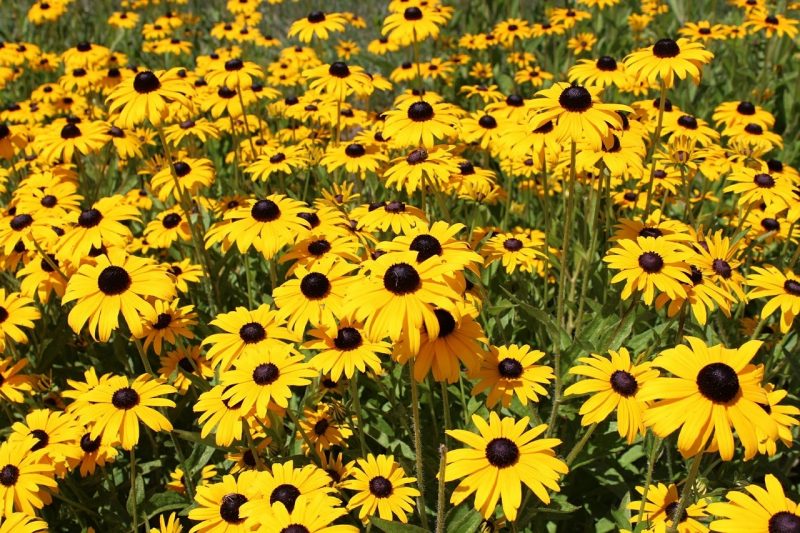You can learn how to prune black eyed susans in the fall by mastering two techniques. Even though they have a relatively short lifespan, you should never overlook these plants’ proper maintenance. This way, you will have tidy and healthy-looking blooms and foliage.
And since pruning can be stressful, you can consider growing black-eyed susans indoors. This way, you don’t risk stressing your plants, and they’ll recover quickly after you cut or deadhead them. This article will also discuss the proper care and maintenance of these plants to help you make the most out of them.

Two Techniques For Pruning Black-Eyed Susans In The Fall
Technique #1. Cutting back
The first technique to master pruning of black-eyed susans in fall is cutting them back. Use this as an opportunity to remove the damaged and withered parts. However, remember to use sharp and sterile shears for a clean cut without the risk of damaging the plant or transmitting diseases in your garden.
You can also cut back black-eyed susans to the ground in fall, after the first frost, as part of maintenance. This will rejuvenate your black-eyed susans for better growth in the next season. Just be mindful not to go deeper in cutting and accidentally damaging the roots, so leave a height of two inches above the soil.
Technique #2. Deadheading
The second technique for pruning black-eyed susans in fall is deadheading. Like most flowering plants, removing the faded flowers will encourage better blooms and even extend the season. More so, removing the flowers will prevent re-seeding that can encourage wildlife in your garden.
You don’t need to wait for the fall to deadhead these plants, and you can deadhead them throughout the growing season to keep them tidy. After the second blooming period in the fall, you can choose to remove the plants or leave them be. The seed heads can feed winter wildlife, but most gardeners decide to keep the area tidy.
Collecting black-eyed susan seeds
To make deadheading more worthwhile, consider collecting the seeds inside the cones of your mature black-eyed susan flowers. You can do this easily by breaking the cone over a surface and then storing the seeds in a paper bag. You can sow in spring or start your plants indoors, depending on your climate.
Some gardeners don’t even collect the seeds. They simply scatter the faded blooms over the garden directly, and the seeds will do the work. However, because they readily germinate, be mindful of this practice to keep them from being invasive.
Fall And Winter Care Of Black-Eyed Susans
Before anything else, remember that you can classify black-eyed susan plants into annual and perennial varieties. With the former, you can expect them to die during winter. Therefore, it’s typical to deadhead them during the flowering period to encourage blooming in the fall.
It’s also common to use this period to remove unhealthy plants and prepare the planting area for next year. On the other hand, perennial black-eyed susan varieties will continue blooming amidst cold climates. You can also deadhead or cut back these plants after blooming as part of their care.
After the first frost, don’t forget to mulch your perennial black-eyed susans and remove them in spring when the weather warms up. You can also remove diseased plants during this time, similar to annual varieties.
Other Fall And Winter Activities For Black-Eyed Susans
You can grow both annual and perennial black-eyed susan varieties from seeds, and you can start collecting the seed heads from your faded flowers. Wait for four weeks to collect them so that it’s easier to gather the ripe and dark-colored seeds. Snip the seed heads from the stems and store them in the refrigerator to stratify the seeds for planting after three months.
If you have older perennial plants, you can divide them every three years as part of maintenance. Dig up your plant in the fall and replant the divisions in a similar area. Water the transplants well but reduce the amount once winter comes.
How To Grow Black-Eyed Susans Successfully
You can grow these plants in early spring in the greenhouse or garden. However, perennial black-eyed susans can also start growing in the fall from seed or transplants. In general, aim to have a soil temperature around 70°F for optimal growth.
Choose an area that has well-draining soil and enough air circulation to avoid fungal diseases. Black-eyed susans will also bloom best somewhere sunny. If you’re growing in the greenhouse, you can use grow lights to provide their light requirements.
Once your plants are well-established, you shouldn’t have any problem with serious diseases and problems. However, don’t forget to acclimate your plants first if you start them in the greenhouse before transplanting them outdoors. Your maintenance afterward will typically focus on pruning.
Conclusion
While black-eyed susans are generally low maintenance, you must still consider learning beneficial practices for their growth. There are two techniques to master if you need to know how to prune black eyed susans in the fall; cutting back and deadheading. Pruning black-eyed susans will allow the plant to rejuvenate itself and even grow better blooms.
You can take advantage of this maintenance practice in the fall to avoid leaving seedheads. More so, pruning will prepare the plant for the winter. Otherwise, you can choose to leave your plants be to help the wildlife in your area during winter.
